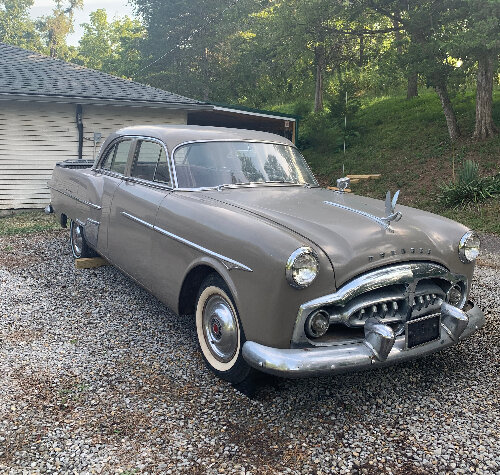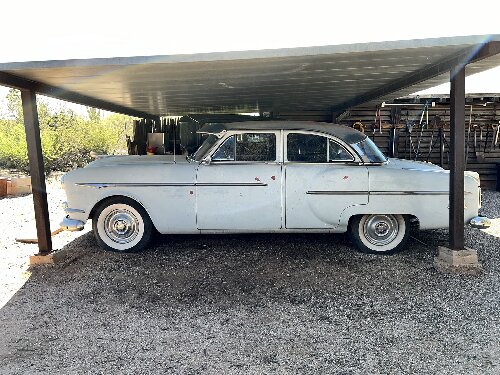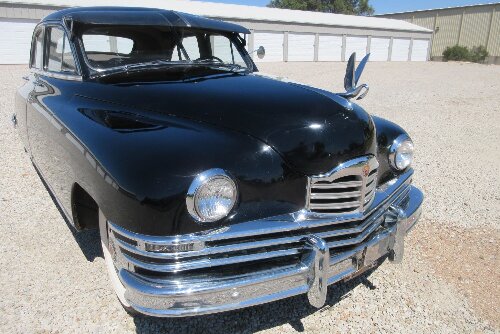|
Re: Ex-Packard Designers
|
||||
|---|---|---|---|---|
|
Forum Ambassador
|
It is surprising that the same person did such remarkably different cars. I think he also had a large hand in other well received Ford products. I seem to recall reading that Reinhart wanted to lower the beltline of the Packards and was shot down by engineering and management-- something about the extra glass that would be needed as being too expensive??
I don't think he was ever a Packard guy but Brooks Stevens was another designer that got a lot of bang for very few bucks. Teague gets his due credit and certainly worth them but didn't an outside industrial design firm come up with the actual 55 front end facelift with Teague doing some refinements and then the 56 changes. It does seem that the GM and Earl's group gets the large share of styling credit -- no matter which company might have built the car. I think Teague lamented in an interview that GM would throw more engineering talent and styling money at designing a door than other companys could spend on an entire car.
Posted on: 2014/7/18 8:42
|
|||
|
Howard
|
||||
|
||||
|
Re: Ex-Packard Designers
|
||||
|---|---|---|---|---|
|
Home away from home

|
Regarding Dick Teague, Mitchell-Bentley and Creative Industries of Detroit... and speaking of books... you will see some surprises in a new book due out next year on Creative. It was a closely kept secret, but Dick Teague actually had a studio at Creative.
Also RE: John Reinhart...actually John had some very futuristic ideas that never saw metal...uh, largely because they were originally intended to be made in fiberglass. He intended these cars as Packards. And this was over a decade before the appearance of a Corvette. Some of Reinhart's future Packards appeared in an article in Esquire magazine in 1941. World War II prevented any of them from happening and after the war, the so-called "bathtub" styling was considered passe (for some reason there were and ARE those who make fun of such design theme on 1948-50 Packard, but then gush praises over the same thing in a Porsche. Go figure). The beautiful Continental Mark II indeed had some Reinhart DNA in it. But others were involved too. Of course, that car was conceived as an open car and thus the explanation of how and why the roof and header were designed as they were. But had Jim Nance succeeded in pulling a rabbit out of a hat with Packard and continued on through the 1957-58 new Packard model years (with real Packards) you can rest assured that there were plans to make a new 12-cylinder luxury personal car. And this one would have made you forget all about the Mark II-as lovely as it was.
Posted on: 2014/7/18 10:13
|
|||
|
||||
|
Re: Ex-Packard Designers
|
||||
|---|---|---|---|---|
|
Forum Ambassador
|
As limited a production run as the Continental MK II had I think an amazingly high percentage of them have survived. Any major auction or mega-swap meet (Hershey, namely) always have one or two for sale. I have seen them in the car corral at Auburn.
Posted on: 2014/7/18 10:38
|
|||
|
||||
|
Re: Ex-Packard Designers
|
||||
|---|---|---|---|---|
|
Home away from home

|
The 55 and 56 are merely the 51-54 Reinharts with a curved windshield,clever face lift and butt lift. And the lift is just a sheet metal stamped extentions sweated to the front and rear fenders.
Posted on: 2014/7/18 11:13
|
|||
|
VAPOR LOCK demystified: See paragraph SEVEN of PMCC documentaion as listed in post #11 of the following thread:f
https://packardinfo.com/xoops/html/modules/newbb/viewtopic.php?topic_id=7245 |
||||
|
||||
|
Re: Ex-Packard Designers
|
||||
|---|---|---|---|---|
|
Forum Ambassador
|
The rear fenders on the 55-56 were stamped that way. The fronts are definitely sweated on, that is plain to see!
Posted on: 2014/7/18 12:47
|
|||
|
||||
|
Re: Ex-Packard Designers
|
||||
|---|---|---|---|---|
|
Home away from home

|
These days, it is not unusual for a car body style to stay largely unchanged for upwards of five years or more. For example, an Impala or Corolla might have some plastic changes to the bumper covers, but the metal fenders remain the same. But when both Packard and Hudson stretched a body style four or five years, their sales suffered the consequences.
How Teague got away with some of his changes to the 56 line still amazes me. For instance, the senior squared 56 trunk lid outer metal stamping is unique, but the inner frame for that lid appears to be one used on the earlier, curvier cars, making the whole lid amortization for a part spread out over less than 11,000 cars produced. Little changes must have cost PMCC big bucks, like when he eliminated the gold vee on the 55 cathedral tail light castings in favor of the 56's red hexigon reflector. But, conversely, those graceful and blended-in exterior door handles stayed the same from 1951 until 1956. Did Teague catch the cost accountants napping, or was he just persuasive in getting some of his ideas approved? Today's Toyota, Ford or FIAT-Chrysler would never let that sort of designer foolishness go on. I'll give my 56 trunk lid and taillights a special wink, knowing that someone like Dick made them special for the year. And I hope that I never have to hunt down a replacement for a one-year-only part. Meanwhile, over at GM, the car line obsolescence was taken to a new height when virtually the entire 1958 model year was replaced after only twelve months. By comparison, a mild re-skinning of the 1958 AMC cars that sold well must have made George Romney look like a genius to industry accountants.
Posted on: 2014/7/18 13:49
|
|||
|
||||
|
Re: Ex-Packard Designers
|
||||
|---|---|---|---|---|
|
Home away from home

|
A few tidbits:
-as I recall Gordon Buehrig of Cord and Auburn fame had a hand in the Mk II Continential. -as far as I'm concernted, the beltline in the 51s is not "too high" but probably lower than the earlier generation Packard and certainly lower than in the Hudsons of the same year. I give Reinhart a lot of credit for the 51 design being as advanced as it was, such as having the fender tops nearly level with the center of the hood...Chevy didn't have that look until 55, Caddie not until 57. The only thing that really tags the 55s as an old design is the vestigial rear fender look, which the other companies were moving away from. -wrt annual styling changes: I read "Built To Better The Best" a few weeks ago, about Kaiser-Frazer. Apparently, it was a requirement of the Auto Manufacturer's Association, of which all US auto manufacturers were members, that every model year of car have unique styling elements. This was a particular problem at Kaiser as their production scheduling was so far off of sales that they kept finishing a model year with thousands of cars laying on dealer's lots (a person was dispatched from Willow Run with a supply of new number plates and the 49s sitting in dealer's lots magically became 50s) and massive inventories of trim and stampings at the plant, which became "special editions" for the next model year.
Posted on: 2014/7/18 17:11
|
|||
|
||||
|
Re: Ex-Packard Designers
|
||||
|---|---|---|---|---|
|
Forum Ambassador

|
Apparently, it was a requirement of the Auto Manufacturer's Association, of which all US auto manufacturers were members, that every model year of car have unique styling elements.
Hard to reconcile that with the 22nd series 1948 and the 22nd series 1949 Packards differing on in the vehicle number. Ditto for 23rd series 1949 and 23rd series 1950. And Chrysler played the same game from 1946 thru 1948. Perhaps a little more research into that alleged AMA requirement would be interesting.
Posted on: 2014/7/18 17:22
|
|||
|
||||
|
Re: Ex-Packard Designers
|
||||
|---|---|---|---|---|
|
Home away from home

|
Perhaps a little more research into that alleged AMA requirement would be interesting.
It may not be readily apparent on the models you cite, or maybe those automakers just decided to accept whatever sanction the AMA dished out. In the book, Mueller writes, of the program to change number plates from a K49 or F49 prefix to K50 or F50 on existing cars in the field: "While motor vehicle departments and finance companies accepted the "new model year" of Kaiser-Frazer, many other groups, including the Automobile Manufacturers Association did not. AMA requirements called for some significant external change to be made between the model years, not just serial numbers." page 70-71. The author, Jack Mueller, is the historian of the Kaiser-Frazer owner's club. He probably has some documentation to back up the statement from his book. His phone number, e-mail and snail mail address are on the club's web site. http://kfclub.com/kfoci-historian/ Jack is very approchable. I e-mailed him about why Kaiser built a stamping plant in eastern Ohio, when the assembly plant was in Ypsilanti. (honking big subsidies from the state of Ohio, and lack of capacity at Fleetwings in PA and at Murray, Briggs and Budd in Detroit was the reason)
Posted on: 2014/7/18 18:43
|
|||
|
||||








